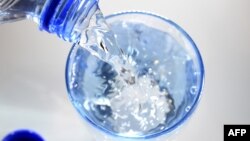A new device can reveal in a matter of seconds whether that drink of water you desperately need is contaminated with disease-causing microorganisms or ready to drink.
The device, called Duo Fluor, can in about 30 seconds test for organic material like decaying plants and animals, and bacteria, including pathogens that cause cholera and dysentery.
John Bridgeman is with the University of Birmingham’s Department of Civil Engineering in England who led a team that developed the device.
“It does not require any chemical, any reagents," Bridgeman says, "and will give you an indication of water quality within just a few seconds.”
The device works by shining a high frequency light into a water sample. If microbes are present in the water, they absorb the photons and emit a weak light back. A thin optical LED instrument detects the fluorescence, which is then processed by a laptop.
The method is especially sensitive to fecal matter and results are almost immediate, compared to the 12 hours it now takes to analyze drinking water.
Its application is evident to the 663 million people the United Nations says don't have ready access to safe drinking water.
And even if the water is running, another 2.4 billion are without adequate sanitation, which makes the water they do have risky.
Universal access to safe water
One of the U.N. Sustainable Development Goals is for all people to have access to safe and affordable drinking water by 2030.
Bridgeman says he hopes Duo Fluor helps the United Nations get there.
“Up until this point,” said Bridgeman, “most of these analysis have been done in the laboratory, using expensive research-grade equipment, which costs tens of thousands of dollars. What we have done is produce an instrument that is smaller than a standard piece of paper.”
The University of Birmingham researcher believes Duo Fluor could be particularly useful at natural disaster sites and refugee camps.
The international aid agency Oxfam is partnering with Bridgeman’s team to help promote and eventually distribute the water tester.




